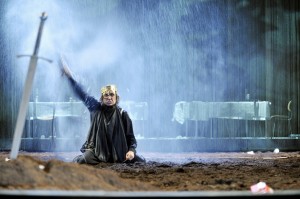
Hamlet is one of Shakespeare’s most famous and yet most difficult tragedies to perform. The reason for this difficulty is the complexity of Hamlet’s character. Often the actors choose one or more idiosyncrasies of character and focus on this, while ignoring the humor and cunning of Hamlet. I once watched a Hamlet who constantly desired to kill his uncle and expressed it through an exaggerated form of anger. Although it is true that Hamlet’s anger towards his uncle Claudius is a key element in the play, an overbearing focus on this can overshadow some other important aspects. Fortunately, German actor Lars Eidinger’s Hamlet had none of these problems in the play that was beautifully performed at the Schaubühne in Berlin on 23rd March (directed by Thomas Ostermeier). In what follows, I will focus on how educational this performance was in showing Hamlet’s character as perhaps Shakespeare would have wanted it to be.
The performance began with the funeral of Hamlet’s father, with all actors on stage attending the event in a comical manner. As they moved around eccentrically on stage, the backdrop showed close-ups of the actors’ facial expressions through a camera which Hamlet was holding. Simultaneously, we heard Hamlet echoing ‘To be or not to be’: ‘Sein oder Nichtsein’. The action then moved onto Gertrude’s marriage and then gradually it focused on Hamlet’s troubled disposition. We see Hamlet as a young man who is suffering from the loss of his father, and grieving over his mother’s marriage with his uncle which has taken place too quickly after his father’s death. Hamlet’s response to the whole situation remains aggressive, yet also very tactful. Hamlet suffers from hallucinatory moments in which he tries to rationalize his grief, yet amidst all this he remains aware of the fact that he has to take revenge for his father’s murder.
Here I must appreciate the director’s effort to give the play a Freudian reading, since the lady who plays Gertrude also plays Hamlet’s lover Ophelia. The costume change between the mother and the lover takes place in front of the audience, even though Hamlet’s and other actors’ responses to both women remain the same. This took me back to our Psychoanalysis Course with ECLA of Bard faculty member Frank Ruda, where we constantly encounter Freud’s claim about the Oedipus complex. According to Freud, we all suffer separation from our mothers and Hamlet’s grief is also very much centered on this. He feels betrayed by his mother’s marriage with Claudius, as evident in Act 4, when Hamlet seizes her tightly and exclaims ‘Frailty, thy name is woman.’ Hamlet’s failed attempt to love his mother unconditionally leaves him divided and conflicted. The performance brought out this aspect by showing a Hamlet who is disgusted and hurt by his mother’s actions.
I really enjoyed the performance since it brings out the element of the Oedipus complex very strongly and mixes it very delicately with some oddly humorous moments in the play. For example, there is a point when Hamlet questions whether he has wronged Laertes, and at this moment Hamlet comes down in the audience along with his microphone and questions the audience as if he were in a quiz show. The audience and actor interaction here was brilliant and it reminded me of my experience at the Globe Theatre in London, when we were constantly advised to keep our interaction with the audience alive. It was indeed one of Shakespeare’s aims to have the actors interact with the audience as much as they can, so that the character is understood like a real life person.
Not only was the performance at the Schaubühne joyful, it also gave me a chance to see one of the stars of Hollywood, Geoffrey Rush, up-close. The play will be performed again in May, and I highly recommend everyone to watch it. It runs with French and English surtitles.
